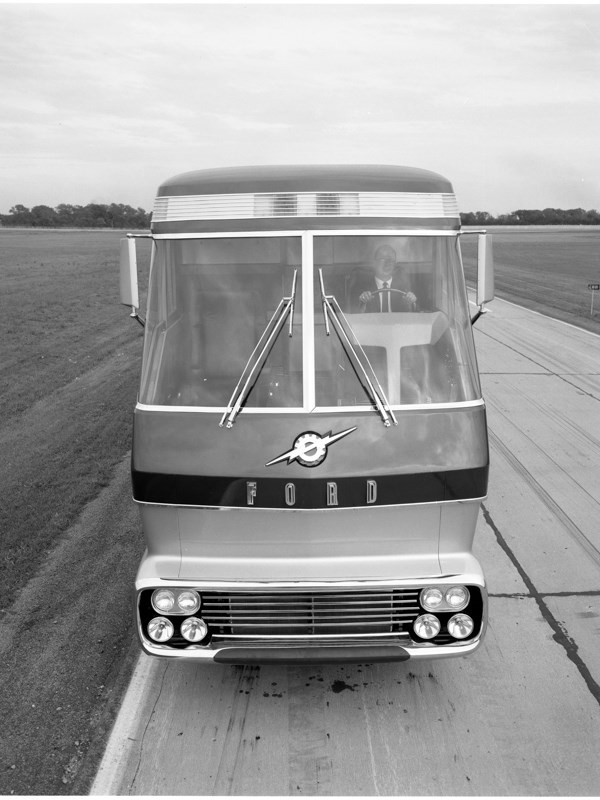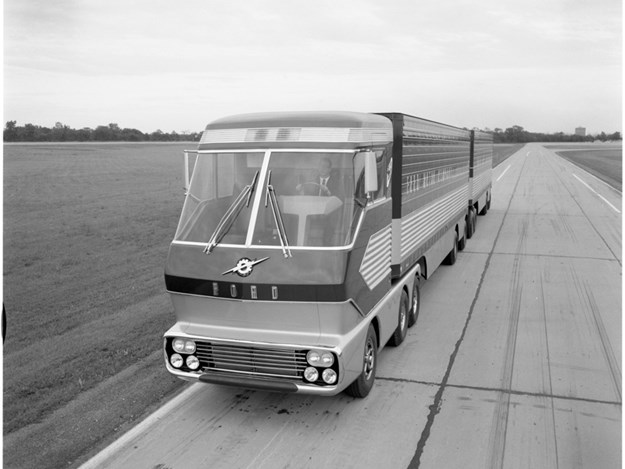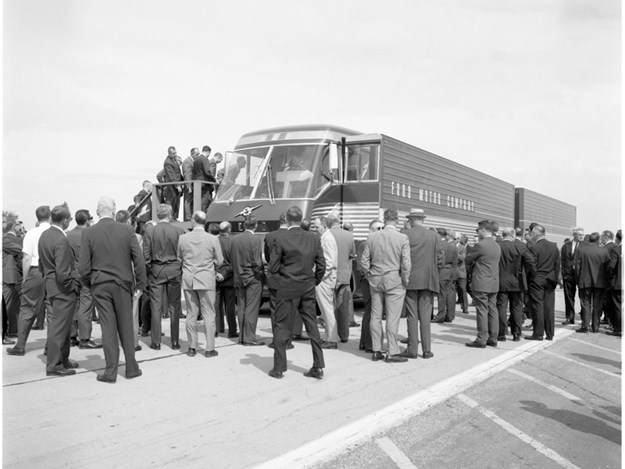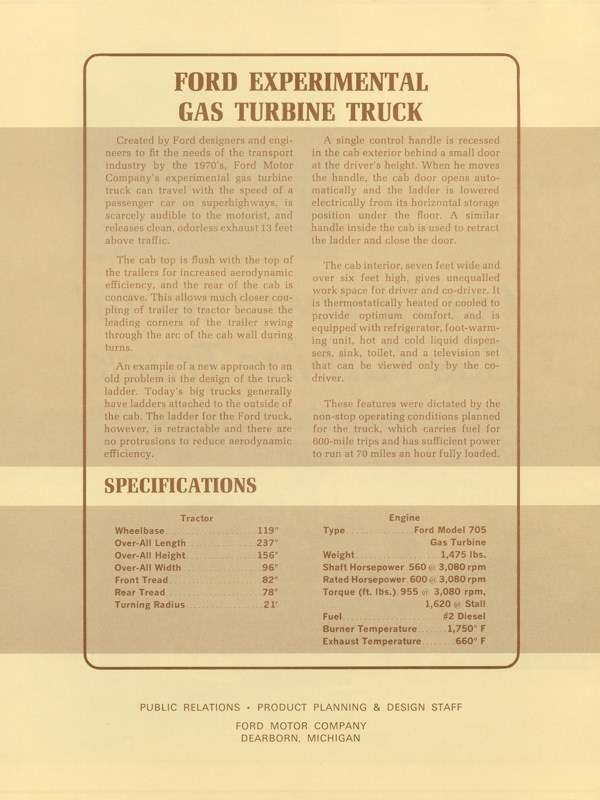Born at a time when engineering curiosity wasn’t suffocated by unimaginative accountants, Ford’s Big Red experimental gas turbine truck blazed a path into a future that never came.
Progress. Besides being a ripper Midnight Oil song it’s an ideal praised and despised in equal measure because of the doubled-edged nature of this man-made concept. Progress in a transformative sense has given us every technological marvel we use today, including the internal combustion engine, but while these labour saving devices have made our lives more convenient, the cost is only now being felt.
Back in 1964 the phrase ‘climate change’ hadn’t been coined, and Ford with its Big Red experimental truck (powered by an engine more at home in aviation circles than on the road) wanted to see what the future could look like when trucks and the relatively new technology of turbine engines were put together. To say the teams involved in the creation of Big Red were excited would be an understatement as it represented pure design and engineering freedom, and the Ford employees at the Blue Oval’s Dearborn, Michigan offices ran with it.
Coast to coast
Arriving at a time when the US was opening super-efficient transport corridors in the form of thousands of miles of freeways running coast-to-coast and everywhere in between, Ford saw Big Red as being the future choice for customers wanting the ultimate load lugger capable of doing big distances quickly in relative comfort.
The days of slow-moving trucks scaling mountain ranges and navigating squirrelly backroads to traverse North America was giving way to a new dawn of logistics promise that offered mostly flat, straight-shot journeys across the entire country. With this proliferation of US highways in the 1960s came the promise of rapid movement of freight nationwide and Ford took full advantage of this promise by creating one of the most ambitious and technologically advanced trucks of its time.
The gas turbine engine at the heart of Big Red was the draw card of the project and was sourced internally from Ford who had a US government contract to develop and provide a gas turbine engine to be used in military applications. Named the 705 (Ford’s gas turbine prototype models were numbered 701-707) this engine punched out 600hp and 1300Nm of twist at a 3080rpm output shaft speed, a reduction gear was used of course with the operating revolutions of the engine topping out at 75,500rpm.
While the power plant which propelled Big Red was wild enough to capture the imagination of the public at large it was the gargantuan proportions and stylised design, especially on the inside, which captured the essence of what the ‘jet age’ was all about. With a massive space-age influenced cabin Big Red offered features for the driver such as a fold-away toilet, kitchen with drink dispenser and food warmer along with a TV that could only be viewed by the co-driver; it was like a hotel on wheels.
Behind the wheel things were just as extraordinary with a massive windscreen that went all the way to the driver’s ankles offering a panoramic view of the road ahead and was a necessity to be able to see regular traffic. A Jetsons-like dashboard with round dials (along with a myriad of instruments mounted in the roof above the driver) told the story of Big Red on the road and were in keeping with the rest of the interior aesthetic.
Debuting to astonished public stares at the 1964 World’s Fair in New York, Big Red captured a dream of future progress and innovation shared by many manufacturers in both light and heavy duty segments with Chrysler’s famous turbine car appearing around the same time as Big Red and Chevrolet’s challenger to the turbine truck crown, the Turbo Titan III, coming soon after.
Far from being a fragile and non-operable concept vehicle as is the norm today, Ford further teased its Big Red concept by strapping a pair of trailers to the truck (an early version of our now ubiquitous B-double) to create a near 30-metre long rig and drove the combination cross-country to promote the possibility of a turbine-propelled future.
Coming in the same year that Ford released the Mustang, Big Red was a sensation and the promotional road trip which took in such US cities as Boston, Philadelphia, Chicago and Los Angeles only further served to burn an indelible impression of Blue Oval technological and styling prowess into the minds of all who saw it.
As a promotional tool Bid Red was a hit, but as with all promo tools retirement came quickly for Ford’s unicorn, which was followed by decades of languishing in obscurity with the whereabouts of the iconic truck only becoming public knowledge last year, decades after it was sold by performance parts peddlers Holman and Moody to a (very) private buyer sometime in the early 1980s.
The come down
Wild concepts from Detroit aren’t anything new but in 1964 Ford had already been pondering gas turbine drive systems for more than a decade and was keen to see the production of a vehicle with aviation-inspired drivetrains alongside its internal combustion V8 offerings. The classic ‘bent Henry’ V8 was the money maker in Ford sales which now gave curious Ford engineers financial leeway to research future propulsion possibilities.
What is really staggering about the whole concept however is the speed of progress Ford made with its turbine technology. It puts into stark contrast the lack of equally ground-breaking technological innovations made in the near 60 years since Big Red first turned a wheel. Think about it. Big Red came along with technology only 20 years old at the time of its creation (though the concept of turbines goes back centuries) with the turbine engine first seeing mass production for World War II planes.
Despite not being able to adapt a gas turbine engine to the slog of pushing what is, aerodynamically at least, the equivalent of a giant brick through the air it was a massively impressive feat that the Ford engineers pulled off at the time.
Looking back on Big Red really poses the question that with all the modern smarts and engineering progress made since 1964, how has trucking evolved since the lumbering oil burners of the time when the Model T was rolling off Henry Ford’s snazzy invention called the production line? The answer is it hasn’t evolved. Progress has been made in some areas for sure, but game-changing propulsion units? Nothing, zero, zip.
But say Ford had chosen a turbine engine over a conventional reciprocating piston diesel engine; would that have been a better option? Probably not as turbine engines have emissions issues (mostly large amounts of NOx) of their own to contend with, though have gotten comparatively cleaner over the last few decades.
What the Big Red experiment highlights is that innovation, mechanical evolution, progress, whatever you want to call it, seems to go in fits and starts as can be evidenced today as all the major truck companies around the world pour billions of dollars into research and development of alternative powertrains that will hopefully pave the way to a cleaner future.
We are now on the cusp of a revolution in trucking that will see electric and hydrogen fuel-cell trucks, take to the streets to deliver a clean transport solution much like Ford spruiked in its advertising materials on Big Red but with a bit more credibility. Ford said of the gas turbine engine advantages in Big Red that it “can travel with the speed of a passenger car on superhighways, is scarcely audible to the motorist, and releases clean, odorless (sic) exhaust 13 feet above traffic.”
All this goes to show Ford knew back in the 1960s that innovation was the way forward, mechanical evolution if you will. Of course, there will be some people who think that diesel is the only answer and sure, if you want to go back to a black and white TV be my guest, but just know that engineers love to solve a problem, and there is no bigger problem currently facing every sector of manufacturing than global warming.
And while electric and hydrogen are the two future favourites, you can’t rule out hydrogen-fuelled internal combustion engines as a possibility, especially as German engine manufacturer Deutz currently offers a six-cylinder hydrogen munching variant that will still make all the ‘vroom vroom’ noises which ICE enthusiasts crave.
The jet age
In the end the question of what the world would look like today if Big Red had made the leap from proof of concept to production truck is moot. The gas turbine engine in a truck idea didn’t stack up back in the day as factors such as truck weight for certain US routes along with the heat generated by the engine, not to mention the US Clean Air Act of 1970, ruled the turbine engine out as a mainstream proposition for the 1960s and ’70s, but lessons learnt by Ford from Big Red, especially in relation to ceramic coatings, are still used today.
But the story doesn’t end there. In fact, Ford continued to refine its gas turbine engine at an assembly plant in Toledo, Ohio where it produced a final iteration. Named the 707 it was a single-stage unit rated at a slightly lower 375hp (280kW) but said to be more fuel efficient than the 705 in Big Red. It presumably continued to service Ford’s military customers but also saw duty in several W-1000 series prime movers used to ferry freight for the automotive giant between its Toledo and Dearborn offices. A 707 is also said to be sitting in the engine bay of a fully-restored Big Red just waiting for the right time to emerge from decades in the shadows.
While Big Red garnered the interest of the public with its space age styling and visionary utility, what resonates most from this 1964 concept is something we can all relate to nearly 60 years later as we move forward into a future where ‘alternative’ drivetrains will soon become the norm.
Specifications
Model: 1964 Ford Big Red
Engine: Ford 705 experimental dual-stage compression, supercharged, gas turbine
Power: 600hp (450kW) @ 3080rpm
Torque: 955ft-lb (1300Nm) @ 3080rpm
Transmission: Five-speed automatic with retarder
Ratios: 1st 2.824, 2nd 2.000, 3rd 1.412, 4th 1.000, 5th 0.706, Reverse 4.769
Length: 237 inches (6019mm)
Length with trailers: 96ft. (29m)
Width: 96 inches (2438mm)
Height: 156 inches (3962mm)
Wheelbase: 119 inches (3022mm)
Weight: 20,000 lbs. (9071kg)
Gross Combination Weight: 170,000lbs. (77,110kg)
Front axle: 12,000lbs. (5443kg)
Rear axle (tandem): 44,000lbs. (19,958kg)
Fuel capacity: 280 gallons (1060 litres)
Fuel economy: circa 2.1mpg (112l/100km)
Top speed: 70mph fully loaded / 78mph at reduced load (112km/h / 125km/h)
Photography: Ford Archives














.jpg)
